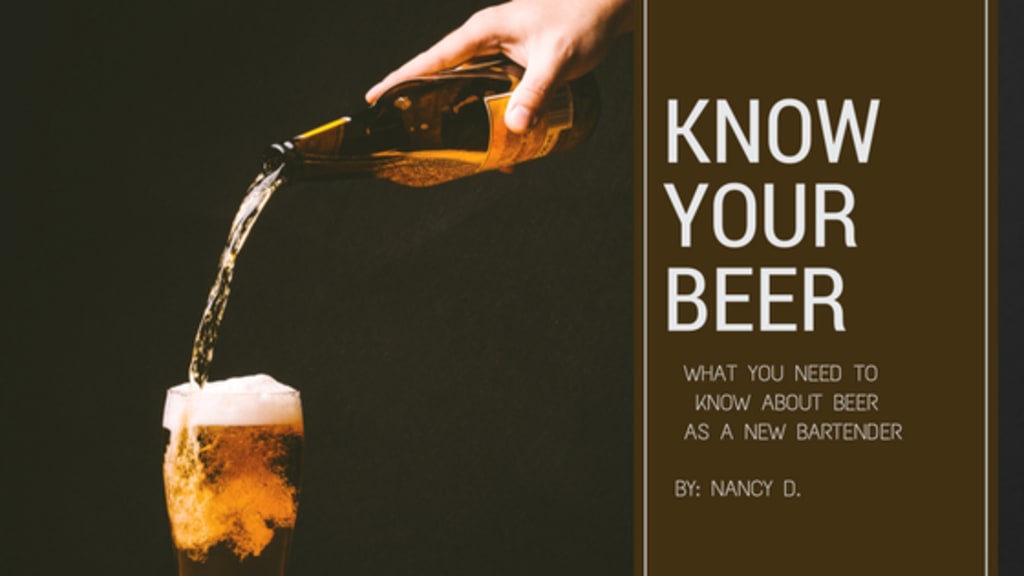
So, you just got a job as a server or maybe even a bartender. Well, then this is the right article for you because it has the absolute most basic knowledge to help you get by without completely embarrassing yourself. Beginning in bartending is mostly just “fake it until you make it” and a little bit of reading helpful articles or watching YouTube videos.
The Absolute Basics
What is beer made from? The answer is: malt + hops + yeast + water
I really doubt that someone will quiz you how beer is made, but my bartending school really stressed knowing this.
There are three main ways a guest will want their beer: draft beer, bottled beer, and canned beer (also known as a tall boy). Guests will want their beer in a very specific way, but may forget to ask. Just remember that when a guest asks for Molson Canadian, the place you work might have it in both tall boys and bottles.
All beer is carbonated! I got really embarrassed about not knowing this one. Also, don’t shake the can before giving them their beer because it will explode like shaken pop.
Just remember, grapes make wine and cereal grains make beer. All alcohol needs to be fermented from something.
The froth on the top of the beer is called "the head." You HAVE to pour the beer from the tap on an angle and let it slide down the glass. Otherwise there will be too much head. I have heard guests talking about a new bartender making their beers half head and half beer and thinking about just leaving it and not drinking it.
On the other end, if there is no head, this is wrong, too. While all beers are different, a general go-to rule is aim for a dime sized amount of head.
Also, the guests may make sexual jokes about you giving them head. If they do, just go with the joke so you can make more tips.
The type of glass you choose for the beer type is extremely important.
At the place I work right now we have a glass with the name of the beer right on it, so it’s pretty easy to figure out which one we should use.
How is it made?
Again, guests probably won’t quiz you on this but it’s better to know this than not know this. I just touched on some basic stuff here.
Milling Malt + Mashing + Lautering +Boiling + Bittering Hops + Aroma Hops + Cooling + Pitching Yeast + Fermenting + Priming Sugar + Bottling + Aging
Since grains don’t ferment by themselves, beer has an extra step called "malting" or "milling malt."
Hops is the most common way to flavour the beer. It is a bitter flavour and has a strong smell. Sugar, coriander, and orange peels are other examples of things used to flavour beer.
Yeast is extremely important; it is what finally turns the grain’s sugars into carbonated alcohol.
Draft Beer!
First things first, never put the faucet into the beer when pouring draft beer!
If you let the faucet touch the beer, it will get all sticky and be an ideal place for bacteria to grow. Also, it just looks gross.
If a guest sees you doing this, they will just start asking for bottles—oh, and they might not tip you.
Get a clean glass!!! I have seen some weird glasses in my life… some with lipstick on them… some with hairs on them, and some with just harmless water stains.
Whatever it is, just use a different glass and fix the weird one later.
I know I already mentioned this, but it’s just really important. The froth is important in draft beer. Managers and guests are very picky about how much froth is on top of their beer when they get it from draft… or even when you pour it from a can for them.
Some draft beers need to sit for a little while before you hand it to the guest.
Keep your beer cold; so chill the glass before dispensing the beer.
At the place I work right now, there is a circle that shoots cold water into the glass; it’s easy and really quick.
Popular Beers
Knowing the popular beers will help you a lot when you are starting. You are suddenly put into a community where these name brands are common knowledge... so get familiar with them!
The top ten most popular beers in Canada are:
Coors Light + Molson Canadian + Budweiser + Bud Light + Blue + Carling Lager + Busch Lager + Alexander Keiths + Heineken + Corona
Great beers that are made in Canada are:
Molsen Canadian + La Fin du Monde + Red Racer IPA + Peche Mortel + Maudite + Alexander Keith’s India Pale Ale + St-Ambroise Pumpkin Ale + Beau’s Lug-Tread Lagered Ale + Denison’s Weissbier + Proppeller London Style Porter
Some popular imported beers are:
Bud Light Radler + Corona + Creemore Springs + Heineken + Alexander Keith’s + Miller Genuine Draft + Moosehead Canadian Lager + Molson Canadian
The Differences Between Lager Beer and Ale Beer
Everywhere I have ever looked for this answer says the exact same thing. Lagers use bottom-fermenting yeast and ales use top-fermenting yeast.
Some people say there is more to understand about the difference, but it’s really not important for beginners, just maybe if you want to pursue this as your career or own a restaurant.
What can be useful to know is that lagers are usually described as lighter, cleaner, and crisper beers while ales are described as richer and fuller in colour, aroma, and even flavour. However, this may be generalizing things a little too much because there are a lot of different beers out there.
The most popular styles of beer is pale lager, but I really doubt anyone will question you on that. Just note that the different kinds of beer are kind of an illusion since most beer is just pale lager…
About the Creator
Nancy D
Facebook @NancyDBlogging
Twitter @BlogsNancy






Comments
There are no comments for this story
Be the first to respond and start the conversation.